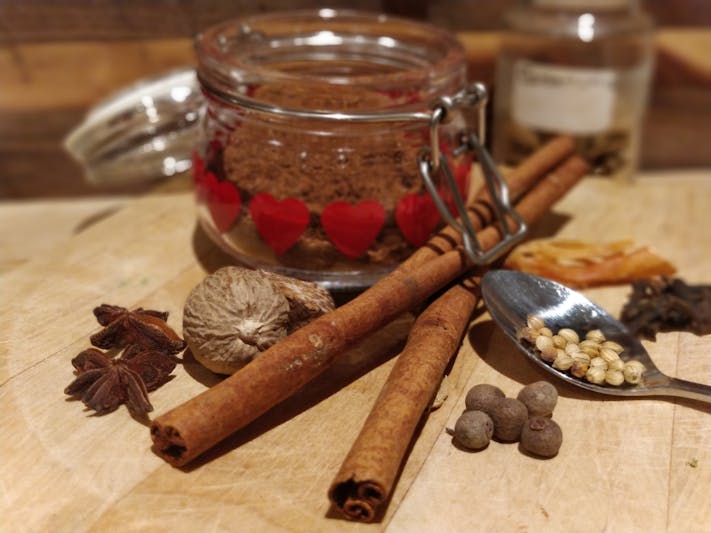Daily Info's Advent Calendar 2018

In the olden days, let's say Tudor times, Christmas was a big affair and a manor house might expect to feed 50 people for several meals a day, for the whole 12 days of Christmas. Epiphany was a bigger celebration than Christmas Day, so the main celebration would have been in January. For a local account, which I recommend reading with your feet up, I'd really recommend Elinor Fettiplace's Receipt Book, found and written out by Hilary Spurling who does a fantastic job of testing all the recipes and giving versions with quantities in case you actually want to cook them, as well as bringing to life the Fettiplace household through a typical year.
The Fettiplaces lived in the manor house at Appleton (just west of Oxford, though it was then in Berkshire due to the extraordinary twists of the Oxon/Berks border). Spurling has waded through Lady Fettiplace's "own crabby black hand and villainous spelling" after the book came into her possession accidentally - she is related to Lady Elinor distantly by marriage, making her the latest in a long line of wives to cook from the book. Being also an award-winning biographer, Spurling was perfectly placed to conjure the words into a whole bustling life.
Spurling points out that of all modern meals, a Christmas roast is probably closest to an Elizabethan feast, with its meaty centrepiece, vegetable dishes, sauces and accompaniments, sweetmeats, steamed plum pudding, gilded chocolates (even if with foil rather than gold leaf), alcohol, and party poppers or crackers to evoke the mayhem of rifles in the great hall. All we need to do is serve all the courses together and lose the potatoes, to make it even more authentic.
Elizabethan Christmas Pudding
Here's Lady Elinor's recipe For A Pudding:
Take twelve eggs & breake them, then take crumbs of bred, & mace & currance & dates cut small, & some oxe suet small minced & some saffron, put all these in a sheepes Mawe, & so boile it.
which goes to show how little things have changed, especially as it was to be eaten with Hard Sauce, which is essentially brandy butter, only made with sack instead of brandy.
Medieval Stewed Capons
For main course, let's go back a little further, to a manuscript that Pepys acquired, but which dates from the 1480s. This manuscript is published in facsimile and modern translation by Gerald Hodgett, under the name Stere Hit Well, and transliterated on www.godecookery.com by James Matterer. Here is the recipe for Stewed Capons:
Take percelly Isope sage Rosemary And tyme breke hit betwene thy hands and stoppe thy capons ther with and color them with saferon And put them yn A erthyn pot or els in brasse for erth is better. And lay splentys underneth and all a boute the sydes so that the capons tuche not the sydes nother the bottom and cast of the same herbys in to the pot A mong the capons And put a quart or A pynte of the best wyne that thow canste gette and no other licour And set A lydde ther A pon that wyll ly with yn the brym. And make batur of white of eggys & floure And put betwene the brym A paper lefe or els lyncloth that the batur may stop hit sowrely that no eyre com owte.

Loke that hit be thyke of bature And set thy pot on A charecole fyre to the myd syde & se that the lydde ryse not with the hette and let hit stew esely and long and whan thow supposyth hit is enowgh take hit fro the fyre yf hit be A pot of erth set hit upon a wyspe of ftraw that hit toche not the cold grownde And when the hete is well drawn and over past take of the lydde And take owte thy capons with a stycke And ley them in A nother vessell and make A syrryp of Wyne And mynct datys and Cannell drawn with the same wyne do ther to rasyns of corance sugur safferon And salt boyle hit A litill And cast yn powder of gynger with a litell of the same wyne do the sew to the syrryppe a bove upon the capons And serue hem furth with A rybbe of beffe ever more a capon on a dysche.
So, a fruity, capon stew, made in an early version of a pressure cooker, and with a surprise rib of beef appearing at the end! (It's possible I'll be eating this for Christmas lunch, since all this historical food research has enthused the rest of our household.)
Tudor Gingerbread
Gingerbread remains eternally popular, especially around Christmas. Gervase Markham, in The English Houswife (1623) gives several recipes, including this rather alcoholic one:
Take Clarret wine and colour it with Townesall, and put in sugar and set it to the fire; Then take wheat bread finely grated and sifted, and licoras, Aniseeds, Ginger and Cinamon beaten very small and searfed ; and put your bread and your spice altogether, and put them into the wine and boile it and stirre it till it be thicke; then mould it and print it at your pleasure, and let it stand neither two moist nor two warme.

Printing, moulding, glazing and then gilding your gingerbread was of course optional, but definitely part of the theatrical nature of a big feast in all the best households. A similar recipe, listed by Markham a few pages later starts with a quart of hony in place of the Clarret. If you want to browse, LSE obligingly has the whole book available digitally through their library website.
Spreading the festive cheer
If you're looking to give something back during the season of giving, check out our charitable suggestion of the day:

Welcome to Daily Info’s 2024 Advent Calendar – 24 days of events to celebrate the festive period and get ready to ring in the New Year!
This year's calendar offers a mix of Christmas activities - pantos, comedy shows, carol concerts etc, taking in traditions in Oxford and the wider area, as well as free diversions in December and some of the best happenings to book ahead for in 2025.


Back to calendar








